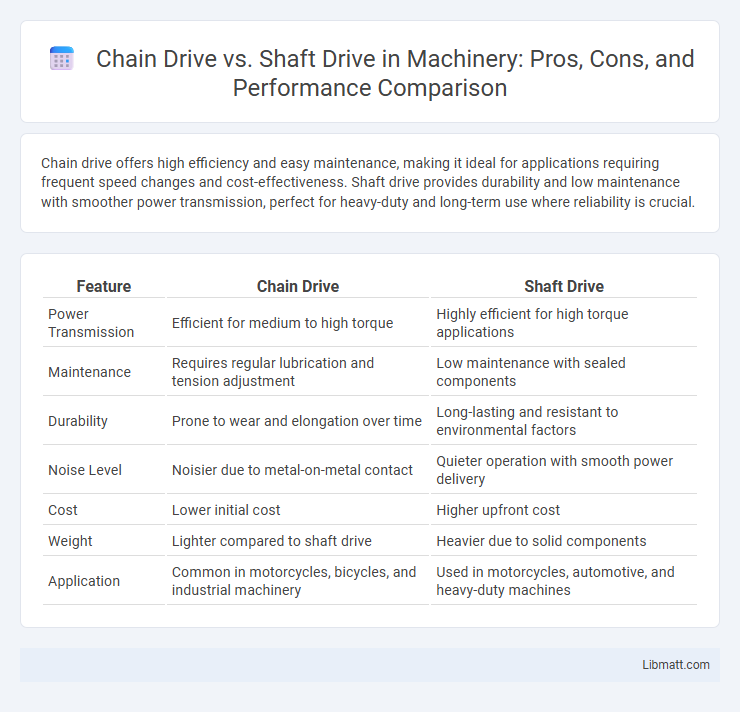Chain drive offers high efficiency and easy maintenance, making it ideal for applications requiring frequent speed changes and cost-effectiveness. Shaft drive provides durability and low maintenance with smoother power transmission, perfect for heavy-duty and long-term use where reliability is crucial.
Table of Comparison
| Feature | Chain Drive | Shaft Drive |
|---|---|---|
| Power Transmission | Efficient for medium to high torque | Highly efficient for high torque applications |
| Maintenance | Requires regular lubrication and tension adjustment | Low maintenance with sealed components |
| Durability | Prone to wear and elongation over time | Long-lasting and resistant to environmental factors |
| Noise Level | Noisier due to metal-on-metal contact | Quieter operation with smooth power delivery |
| Cost | Lower initial cost | Higher upfront cost |
| Weight | Lighter compared to shaft drive | Heavier due to solid components |
| Application | Common in motorcycles, bicycles, and industrial machinery | Used in motorcycles, automotive, and heavy-duty machines |
Introduction to Chain Drive and Shaft Drive
Chain drives utilize a looped metal chain to transfer power between sprockets, offering efficient torque transmission in motorcycles and bicycles. Shaft drives employ a rotating shaft with bevel gears to deliver power, providing low maintenance and durability in high-performance motorcycles. Understanding the mechanical differences and application contexts helps optimize drivetrain selection for specific vehicle needs.
How Chain Drives Work
Chain drives transmit mechanical power by engaging a chain with sprockets on the driving and driven shafts, converting rotational motion efficiently. The chain consists of interlinked metal plates that wrap around sprockets, maintaining positive engagement without slipping. This system allows for customizable gear ratios, durability, and easy maintenance, making it ideal for motorcycles and bicycles.
How Shaft Drives Work
Shaft drives transfer power from the engine to the rear wheel using a rotating metal shaft enclosed within a protective housing, offering a low-maintenance alternative to chain drives. The drive shaft connects to a bevel gear mechanism, which changes the rotational axis by 90 degrees to turn the rear wheel smoothly and efficiently. This system provides durability, reduced lubrication needs, and cleaner operation, commonly found in touring motorcycles and some high-end cruisers.
Performance Comparison: Chain vs Shaft
Chain drives offer superior efficiency and acceleration due to their lighter weight and direct power transfer, making them ideal for performance motorcycles. Shaft drives provide smoother, low-maintenance operation with consistent power delivery, though they are heavier and can slightly reduce acceleration. Your choice between chain and shaft drive depends on whether you prioritize maximum performance or durability and ease of maintenance.
Maintenance Requirements
Chain drives require regular lubrication, tension adjustments, and inspection for wear to ensure optimal performance and prevent premature failure. Shaft drives demand less frequent maintenance, typically involving periodic lubrication of the enclosed driveshaft and seals, resulting in lower ongoing upkeep. Choosing between the two affects Your maintenance schedule, with chain drives being more hands-on and shaft drives offering a more low-maintenance solution.
Cost Considerations
Chain drives generally offer a lower initial cost and easier maintenance compared to shaft drives, making them a preferred choice for budget-sensitive projects. Shaft drives, while more expensive upfront due to complex components and materials, provide longer service life and reduced maintenance expenses over time. Evaluating total cost of ownership, including installation and repair, often reveals shaft drives as a more cost-effective solution in the long run despite higher initial investment.
Durability and Longevity
Chain drives offer high durability with proper maintenance, but they are more susceptible to wear and require regular lubrication and tension adjustments. Shaft drives provide superior longevity and consistent performance due to enclosed, low-maintenance construction, making them highly resistant to dirt and weather conditions. Your choice between chain drive and shaft drive affects maintenance frequency and overall lifespan, with shaft drives typically lasting longer under harsh usage.
Suitability for Different Motorcycle Types
Chain drives excel in off-road and sport motorcycles due to their lightweight design, high efficiency, and ease of customization for varying gear ratios. Shaft drives provide superior durability and low maintenance, making them ideal for touring and cruiser motorcycles designed for long-distance comfort and reliability. Touring and cruiser motorcycles benefit from smoother power transmission and reduced mechanical wear found in shaft drive systems.
Pros and Cons of Chain and Shaft Drives
Chain drives offer high efficiency and easy maintenance, with the ability to handle high torque and provide better power transfer, but they require regular lubrication and adjustment due to wear and potential noise. Shaft drives deliver low maintenance, clean operation, and durability with sealed systems that resist dirt and moisture, yet they tend to be heavier, more expensive, and can cause slight power losses from additional mechanical complexity. Choosing between chain and shaft drives involves balancing chain drives' cost-effective performance and maintenance needs against shaft drives' reliability and minimal upkeep.
Which Drive System Should You Choose?
Choosing between a chain drive and shaft drive depends on maintenance, efficiency, and riding preferences. Chain drives offer superior power transfer efficiency and easy customization but require regular cleaning and lubrication. Shaft drives provide low maintenance and reliability with less drivetrain wear, making them ideal for long-distance touring and commuting.
Chain drive vs shaft drive Infographic

 libmatt.com
libmatt.com